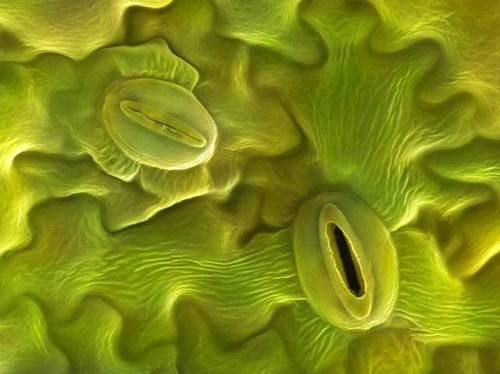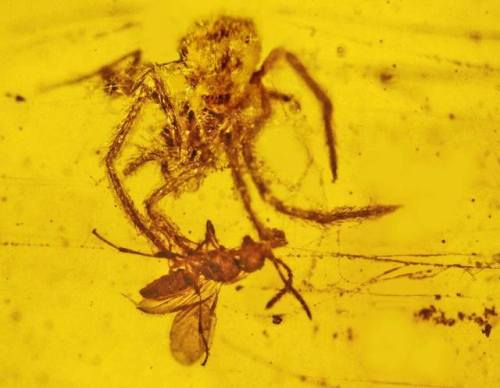Stomata As A Proxy For Atmospheric CO2 Levels

Stomata as a Proxy for Atmospheric CO2 Levels
These strange, mouth-like structures are called stomata. Stomata are specialized pore structures found on plant leaves that permit the exchange of gases such as CO2, O2 and H2O, between the inside and outside of the leaf. They do so through the opening and closing of stomatal guard cells.
Plants convert visible light into sugars via the process of photosynthesis, which uses CO2 as a reactant. Along with light availability and temperature, CO2 is a limiting reactant of photosynthesis which means that the quantity of this compound controls the number of reactions that can take place.
Keep reading
More Posts from Rocks-everywhere and Others

supermassive black hole

A predatory moment, frozen in geological time
You’re a hungry spider who is rushing towards a wasp that has become entangled in your web when all of a sudden everything goes sticky, you can’t move, frozen in place like the proverbial Tantalus with your food in sight but forever beyond your reach. Very soon after you are engulfed in another wash of sticky sap oozing out of a tree and everything goes dark. The spider may ironically have also been courting a painful death, since these wasps are parasitic and known to lay their eggs in spiders and other insects, with the larvae slowly consuming the insect from the inside out, preserving it alive by leaving the vital organs for last. Such a moment was caught by a unique fossil pictured below, that turned up in a hundred million year old piece of amber from what is now the Hukawng valley in Burma.
Keep reading

When Dwarfs Meet Giants, and Other True Cosmic Fairy Tales
It’s easy to get lost in fantasy worlds through science-fiction movies and novels, but did you know that some of your favorite fairy tale characters actually exist in cosmic form? From dwarfs and giants to shape-shifters and buried treasure, the universe is home to a multitude of mystical objects.
White Dwarf Stars

You’ve probably heard of dwarfs like Happy and Sneezy (or Gimli and Thorin), but it’s unlikely you’re familiar with the space-dwelling dwarfs with names like Sirius B and ASASSN-16oh. White dwarf stars like these are typically about the size of Earth, which is pretty small as far as stars go. They represent one of three final stages of stellar evolution, along with neutron stars and black holes. Each star’s mass determines which one it will ultimately become. Stars much more massive than the Sun typically become neutron stars or black holes, and lower-mass stars end up as white dwarfs.

Our Sun will eventually become a white dwarf after it exhausts its fuel, but don’t worry — we’ve got several billion years to go! Before it is reduced to a white dwarf it will actually expand into a red giant, swelling out to encompass Earth’s orbit. But we don’t have to wait billions of years to see stellar giants … some already peek out at us from the cosmic deep.
Giants and Supergiants

The red giant star Aldebaran, located about 65 light-years away, is about 5,000 times bigger than Earth. Our Cassini spacecraft imaged Aldebaran through Saturn’s rings in 2006, but you can see it for yourself during northern winter. Just look for the brightest star in the constellation Taurus.

Fairy tale giants may be taller than trees, but these supergiant stars can be over 100,000 times “taller” than our entire planet! Supergiant stars are likely becoming more rare as time goes on. While scientists believe they used to be more common, our whole galaxy now contains just a small smattering of supergiants.

These massive stars grace the galaxy for a relatively small amount of time. They burn through their fuel extremely quickly — in just a few million years, as opposed to hundreds of billions of years for the smallest stars! Supergiants often end their lives in dramatic explosions called supernovae.

Betelgeuse — the bright, reddish star marking the shoulder of Orion — is nearing the end of its life and has expanded to become a red supergiant star. It is destined to explode as a supernova, which might happen tonight … or within the next few hundred thousand years.
Ghostly Solar Neutrinos

Even an average star like our Sun has some seemingly magical qualities. Each second, it sends billions of phantom-like neutrino particles out into space. They travel almost as fast as light and don’t usually interact with normal matter. Billions of them are zipping harmlessly straight through your body while you read this. Even at night they go through the entire Earth before reaching you!

But that’s not all … these ghostly particles are shape-shifters, too! Neutrinos can change characteristics over time, morphing between different versions of themselves. Spooky!
Buried Treasure in the Heart of the Galaxy

Extensive clouds of dust enshroud the heart of our Milky Way galaxy, hiding it from our view — at least when it comes to visible light. The dust isn’t as big a problem for infrared light, however, which has allowed us to get a glimpse of our galaxy’s chaotic core thanks to our Hubble and Spitzer space telescopes.

Future missions may peer into the galactic core in search of buried treasure — thousands of planets orbiting distant stars!
Want to learn about more cosmic objects? Find them here!
Make sure to follow us on Tumblr for your regular dose of space: http://nasa.tumblr.com
rodrigo.paleontologist
Did you know many regular sidewalks can have body or trace fossils on them? Here I show you a sidewalk in southern Brazil (Dois Irmãos-RS) with marine invertebrate displacement trace fossils. These rocks are from the Late Carboniferous Rio do Sul Formation (Paraná Basin). Your strolls in town will never be the same now!



Fluorite - Schacht 78 Mine, Frohnau, Annaberg, Saxony, Germany

On one side this may look like just a ordinary clam shell but when you flip it over it contains beautiful golden calcite crystals. The crystals formed when the clam died and a cavity formed allowing the crystals to develop. Took over two million years to do this. Found on the east coast of Florida in Brevard County.
capturing_the_cosmos
too many songs about love. not enough songs about sword fights
cave exploring, thailand
-
 02dogs liked this · 1 year ago
02dogs liked this · 1 year ago -
 foryoursummer-blog liked this · 5 years ago
foryoursummer-blog liked this · 5 years ago -
 floweramon reblogged this · 6 years ago
floweramon reblogged this · 6 years ago -
 random-nerd-queer liked this · 6 years ago
random-nerd-queer liked this · 6 years ago -
 fuckyeahyonicsymbols reblogged this · 6 years ago
fuckyeahyonicsymbols reblogged this · 6 years ago -
 billysquirrel liked this · 6 years ago
billysquirrel liked this · 6 years ago -
 wheredoipanic-blog liked this · 6 years ago
wheredoipanic-blog liked this · 6 years ago -
 triggeredstims reblogged this · 6 years ago
triggeredstims reblogged this · 6 years ago -
 enchantingcalzonewagonpasta-blog liked this · 6 years ago
enchantingcalzonewagonpasta-blog liked this · 6 years ago -
 carasilverfern reblogged this · 6 years ago
carasilverfern reblogged this · 6 years ago -
 bettyjane55-blog liked this · 6 years ago
bettyjane55-blog liked this · 6 years ago -
 bleugrl liked this · 6 years ago
bleugrl liked this · 6 years ago -
 silllis liked this · 6 years ago
silllis liked this · 6 years ago -
 burning--incandescently reblogged this · 6 years ago
burning--incandescently reblogged this · 6 years ago -
 muddy-axolitl liked this · 6 years ago
muddy-axolitl liked this · 6 years ago -
 ineedbirds liked this · 6 years ago
ineedbirds liked this · 6 years ago -
 chanheewoo-blog liked this · 6 years ago
chanheewoo-blog liked this · 6 years ago -
 lunamonte liked this · 6 years ago
lunamonte liked this · 6 years ago -
 nucleic-artist liked this · 6 years ago
nucleic-artist liked this · 6 years ago -
 catshapeddarkness liked this · 6 years ago
catshapeddarkness liked this · 6 years ago -
 thin-lace liked this · 6 years ago
thin-lace liked this · 6 years ago -
 nurnielfa liked this · 6 years ago
nurnielfa liked this · 6 years ago -
 carol1st reblogged this · 6 years ago
carol1st reblogged this · 6 years ago -
 armoreddragon liked this · 6 years ago
armoreddragon liked this · 6 years ago -
 jbe200 liked this · 6 years ago
jbe200 liked this · 6 years ago -
 mcfrickjagger reblogged this · 6 years ago
mcfrickjagger reblogged this · 6 years ago -
 sugar-splenda reblogged this · 6 years ago
sugar-splenda reblogged this · 6 years ago -
 sugar-splenda liked this · 6 years ago
sugar-splenda liked this · 6 years ago -
 badtextures reblogged this · 6 years ago
badtextures reblogged this · 6 years ago -
 colias liked this · 6 years ago
colias liked this · 6 years ago -
 omcgowan liked this · 6 years ago
omcgowan liked this · 6 years ago -
 tchyp liked this · 6 years ago
tchyp liked this · 6 years ago -
 ht-pantu liked this · 6 years ago
ht-pantu liked this · 6 years ago -
 bblossam liked this · 6 years ago
bblossam liked this · 6 years ago -
 paleontologylife reblogged this · 6 years ago
paleontologylife reblogged this · 6 years ago -
 paleontologylife liked this · 6 years ago
paleontologylife liked this · 6 years ago -
 fineaslv liked this · 6 years ago
fineaslv liked this · 6 years ago -
 nonamenothanksno liked this · 6 years ago
nonamenothanksno liked this · 6 years ago -
 viearbre liked this · 6 years ago
viearbre liked this · 6 years ago -
 messiestobjects reblogged this · 6 years ago
messiestobjects reblogged this · 6 years ago
225 posts